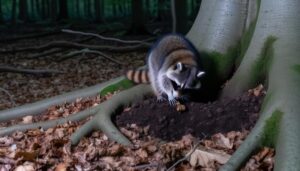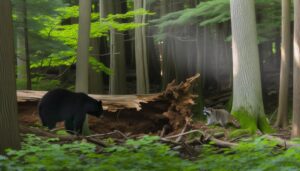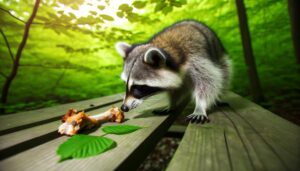Do Raccoons Eat Mice and Rats?
Yes, raccoons consume mice and rats as part of their omnivorous diet. These mammals display significant dexterity and keen senses, aiding them in ambushing and capturing small mammals effectively.
In various environments, whether rural or urban, raccoons adapt their hunting techniques to available prey, including rodents. This predatory behavior benefits ecosystems by naturally regulating rodent populations and mitigating related diseases and agricultural damage.
Such dietary habits highlight the raccoons' role in maintaining ecological balance and providing eco-friendly pest control. For a deeper understanding of raccoons' predatory impacts and their interactions with humans, more detailed observations are provided.
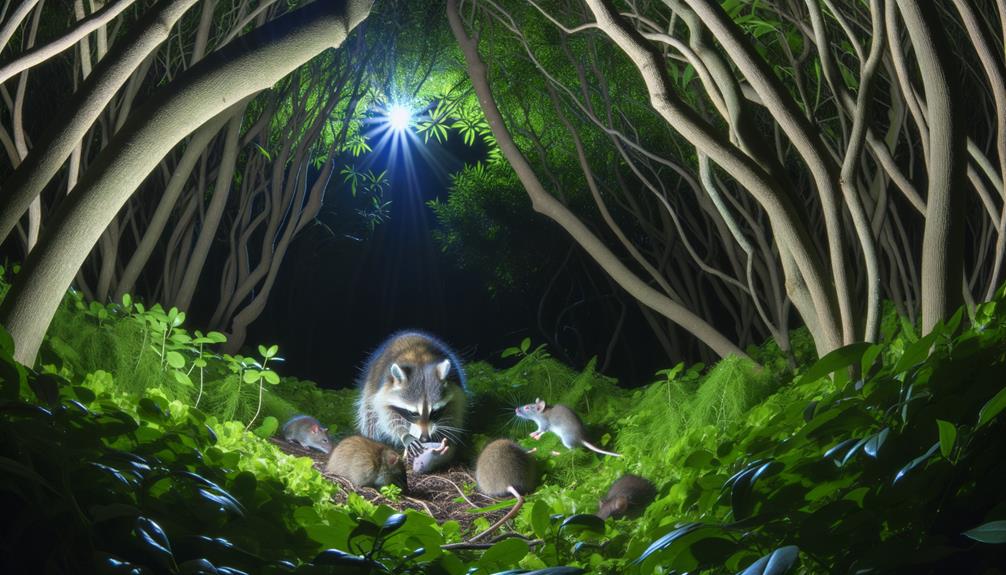
Key Takeaways
- Raccoons are omnivores and do eat mice and rats as part of their diet.
- They use their hunting skills, such as dexterity and night vision, to catch small rodents.
- Raccoons help control rodent populations naturally, reducing the need for chemical pesticides.
- In urban environments, raccoons adapt and prey on mice and rats found in human-modified landscapes.
- Their predatory behavior contributes to reducing rodent-borne diseases and agricultural damage.
Raccoon Dietary Overview
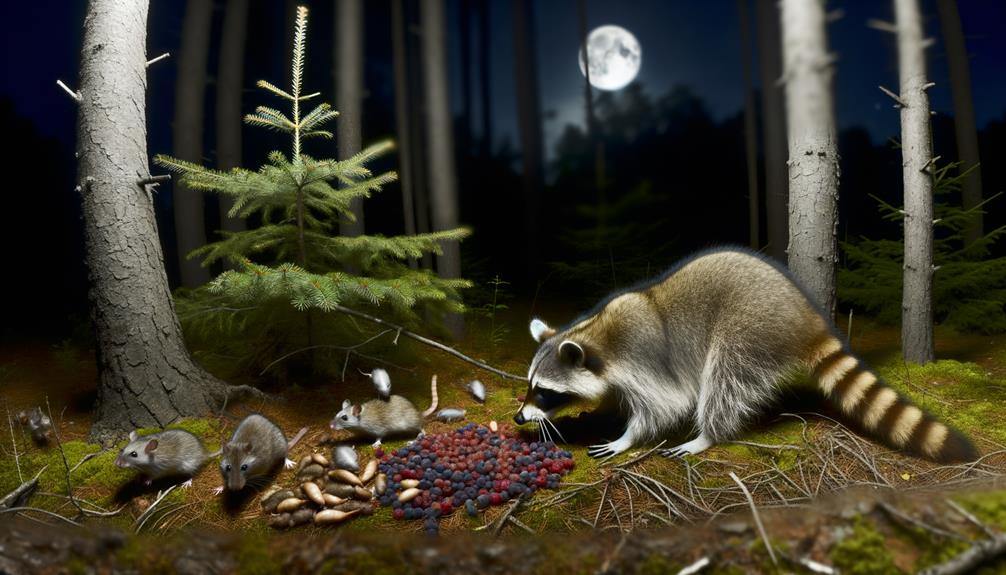
Raccoons, known scientifically as Procyon lotor, exhibit an omnivorous diet that encompasses a wide range of plant and animal matter. Their diet includes fruits, nuts, berries, seeds, and various invertebrates such as insects and crustaceans. Additionally, raccoons consume vertebrates, including small mammals, birds, and amphibians.
They are also known to forage in human habitats, scavenging through garbage and compost for edible waste. Seasonal availability of food sources greatly influences their dietary habits, leading to variations in consumption patterns throughout the year.
Observations indicate that raccoons are opportunistic feeders, adapting their diet based on the immediate availability of resources. This dietary flexibility is a key factor in their ability to thrive in diverse environments, from urban areas to natural forests.
Natural Hunting Skills
Exhibiting remarkable dexterity and intelligence, these nocturnal creatures employ a range of natural hunting skills to capture their prey. Raccoons possess highly sensitive front paws, which they utilize to feel and manipulate objects in the dark. This tactile acuity allows them to detect and seize small prey such as mice and rats with precision.
Additionally, their keen sense of hearing and night vision enhance their ability to locate prey in low-light conditions. Observations indicate that raccoons often employ stealth and patience, quietly stalking their targets before executing a swift attack. These adaptive hunting skills enable raccoons to effectively exploit various food sources, contributing to their success as opportunistic omnivores in diverse environments.
Predatory Behavior

Predatory behavior in raccoons is characterized by their methodical approach and strategic use of environmental features to ambush and capture prey. Their acute sense of touch and dexterous front paws enable them to detect and seize small animals such as mice and rats. Raccoons exhibit a keen understanding of their surroundings, often utilizing natural cover and darkness to their advantage. Observations indicate that they are opportunistic predators, adapting their hunting techniques based on prey availability and environmental conditions. This behavior is indicative of their broader ecological adaptability and survival strategies.
| Characteristic | Description |
|---|---|
| Hunting Method | Ambush and capture |
| Sensory Adaptations | Acute touch, dexterous paws |
| Environmental Use | Natural cover and darkness |
| Predatory Adaptability | Opportunistic and flexible techniques |
Their predatory behavior underscores their role as versatile and efficient hunters within their ecosystems.
Nutritional Needs
Raccoons have specific nutritional needs that dictate their feeding behavior and dietary choices. Protein requirements are critical for their growth, reproduction, and overall health, while energy sources such as fats and carbohydrates provide the necessary fuel for their active lifestyles.
Additionally, dietary diversity guarantees that raccoons obtain a balanced intake of essential vitamins and minerals.
Protein Requirements
Understanding the protein requirements of raccoons necessitates a detailed examination of their dietary habits and nutritional needs. Raccoons are omnivorous animals that require a balanced diet rich in protein to maintain their health. Protein is essential for muscle development, immune function, and overall energy. Their diet typically includes a variety of protein sources such as insects, small mammals, and amphibians. The inclusion of mice and rats can greatly contribute to fulfilling these requirements. The table below outlines common protein sources and their contribution to a raccoon's diet.
| Protein Source | Example Foods | Protein Contribution (%) |
|---|---|---|
| Insects | Beetles, grasshoppers | 25-30% |
| Small Mammals | Mice, rats | 20-25% |
| Amphibians | Frogs, toads | 15-20% |
| Aquatic Animals | Fish, crayfish | 10-15% |
This balanced intake guarantees raccoons meet their protein needs effectively.
Energy Sources
In addition to protein, raccoons need diverse energy sources to sustain their active lifestyle and metabolic functions. Carbohydrates play a pivotal role, providing immediate energy for activities such as foraging and evading predators.
Fats serve as a dense energy reserve, particularly important during colder months when food availability diminishes. The inclusion of complex carbohydrates, like those found in fruits and vegetables, supports prolonged energy release, while simple sugars offer rapid but short-lived boosts.
Observational studies highlight raccoons' adeptness at sourcing varied energy-rich foods, from acorns and berries to human refuse. This dietary adaptability ensures they meet their caloric needs despite environmental fluctuations.
Therefore, a well-rounded intake of carbohydrates and fats complements their protein consumption effectively.
Dietary Variety
Why do raccoons exhibit such a broad dietary spectrum, encompassing a wide array of nutritional sources to fulfill their physiological needs?
The answer lies in their omnivorous nature, which enables them to adapt to diverse environments.
Raccoons consume a variety of foods, including fruits, nuts, insects, small mammals like mice and rats, and even human refuse.
This dietary flexibility allows them to obtain essential nutrients, such as proteins, fats, carbohydrates, vitamins, and minerals, essential for their survival and reproduction.
Their opportunistic feeding habits also aid in maintaining energy balance and supporting their immune systems.
This adaptability in diet is a key factor in the raccoon's ability to thrive in both urban and natural habitats.
Urban Vs. Rural Diets
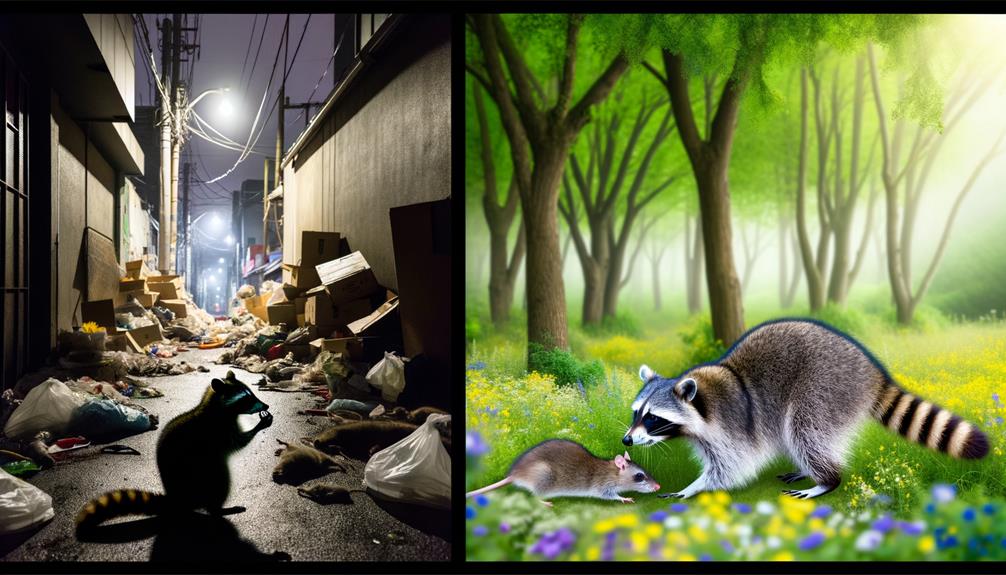
Raccoons exhibit notable differences in their dietary patterns depending on whether they inhabit urban or rural environments. In rural settings, raccoons primarily consume a diet rich in natural sources, such as fruits, nuts, insects, and small vertebrates, including mice and rats. Their foraging behavior is influenced by the availability of these natural food resources.
Conversely, urban raccoons adapt to human-modified landscapes by exploiting anthropogenic food sources. They often scavenge from garbage bins, pet food dishes, and other human-related waste, which can result in a more varied and less seasonally dependent diet. Despite these adaptations, urban raccoons do not completely abandon their predatory instincts and may still hunt small mammals when given the opportunity.
Seasonal Eating Patterns
Seasonal variations immensely influence the dietary habits of raccoons, dictating the availability and type of food sources they can access throughout the year. During the warmer months, raccoons often consume a diverse array of foods, including fruits, insects, and small mammals like mice and rats. However, as temperatures drop, their diet shifts significantly.
Winter scarcity drives raccoons to rely more on stored body fat and available food sources such as:
- Leftover human food from trash bins
- Nuts and seeds collected during fall
- Small mammals like rodents, when other food is scarce
- Aquatic organisms such as crayfish and fish, if accessible
These adaptations underscore the raccoon's opportunistic feeding behavior, essential for survival across varying seasonal conditions.
Impact on Rodent Populations

The opportunistic feeding behavior of raccoons, particularly their consumption of small mammals like mice and rats, plays a significant role in influencing local rodent populations. By preying on these small mammals, raccoons can indirectly regulate the abundance of rodent species within their habitats. This predatory pressure can lead to notable fluctuations in rodent population dynamics, impacting both their numerical density and spatial distribution. Moreover, the presence of raccoons may deter rodent activity in certain areas, thereby creating a more balanced ecosystem.
| Aspect | Observation | Impact |
|---|---|---|
| Population Density | Decrease | Lower rodent numbers |
| Spatial Distribution | Shift | Rodents avoid raccoon zones |
| Reproductive Rates | Possibly Reduced | Fewer breeding opportunities |
| Ecosystem Balance | Enhanced | Greater biodiversity |
This intricate interplay underscores the ecological significance of raccoons within their environments.
Pest Control Benefits
Raccoons, as natural rodent predators, play a significant role in reducing the populations of mice and rats, thereby contributing to pest control efforts. Their predation on these rodents offers an eco-friendly solution compared to chemical pest control methods, which can have adverse environmental impacts.
Understanding the raccoons' role in ecosystem dynamics can inform integrated pest management strategies.
Natural Rodent Predators
Understanding the role of natural rodent predators, such as raccoons, provides valuable insights into their contributions to pest control and ecosystem balance. These predators play a significant role in curbing rodent populations, which can mitigate the spread of diseases and agricultural damage. Detailed observations reveal that raccoons, in pursuit of a varied diet, often prey on mice and rats, thereby contributing to a healthier environment.
Key benefits of natural rodent predators include:
- Disease Control: Reduction in rodent-borne diseases impacting humans and pets.
- Agricultural Protection: Decreased rodent damage to crops and stored food.
- Biodiversity Preservation: Maintenance of prey-predator balance in ecosystems.
- Economic Savings: Lower reliance on chemical pest control methods.
This natural regulation underscores the importance of raccoons and similar predators in maintaining ecological harmony.
Reducing Rodent Populations
By naturally curbing rodent populations, raccoons contribute significantly to effective and sustainable pest control measures. These nocturnal omnivores actively hunt and consume mice and rats, thereby reducing the prevalence of these rodents in various ecosystems. Empirical studies indicate that raccoons' predatory behavior helps to maintain a balance within their habitats, mitigating the risks associated with rodent overpopulation, such as the spread of diseases and agricultural damage.
This ecological role offers a natural and cost-effective pest control solution, reducing the need for chemical interventions. Detailed observations reveal that raccoons' dietary habits are opportunistic, allowing them to adapt to fluctuating rodent populations, ensuring a consistent presence of natural rodent control agents in the environment.
Eco-friendly Pest Solutions
Empirical evidence underscores that leveraging raccoons' natural predatory behaviors can be an integral component of eco-friendly pest management strategies. By utilizing raccoons in this capacity, several benefits can be observed:
- Reduction in Chemical Use: Natural predation reduces the need for harmful pesticides.
- Biodiversity Support: Encouraging raccoon presence can promote a balanced ecosystem.
- Cost-Effectiveness: Dependence on native predators can lower pest control expenses.
- Sustainable Practices: Utilizing raccoons aligns with long-term environmental sustainability goals.
These benefits highlight the importance of considering raccoons in integrated pest management (IPM) plans. Detailed observations indicate that raccoons are effective at controlling rodent populations without the negative impacts associated with chemical interventions. This approach not only protects the environment but also fosters a healthier, balanced ecosystem.
Risks and Challenges
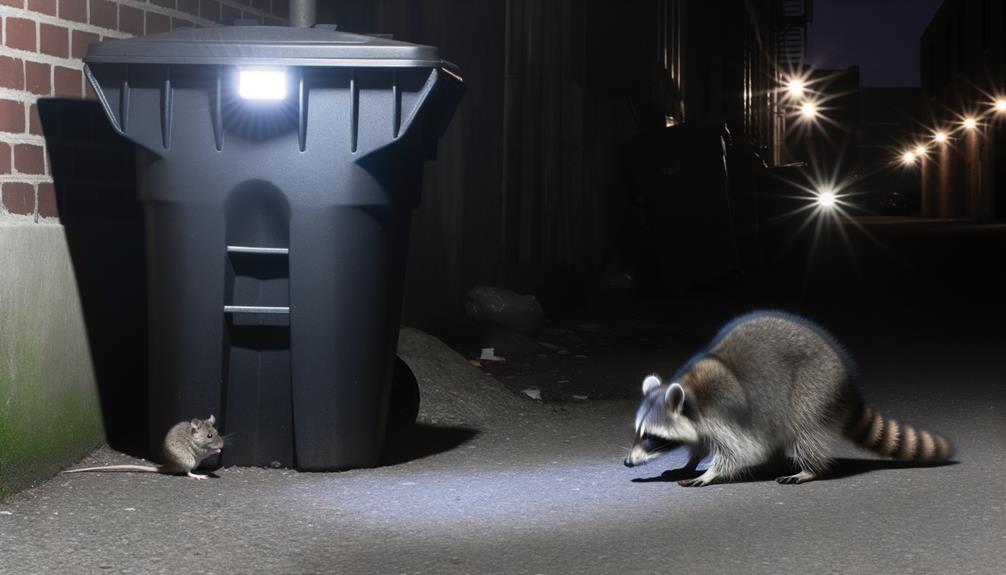
Predation on mice and rats by raccoons presents several ecological and health-related risks and challenges. Ecologically, raccoons can disrupt local ecosystems by over-predation, leading to imbalanced prey populations. Health risks include the potential transmission of zoonotic diseases such as leptospirosis and rabies, which can spread from raccoons to humans and pets. Additionally, raccoons may become dependent on human habitats, leading to increased human-wildlife conflicts.
Below is a table summarizing key risks and challenges:
| Risk Type | Description | Impact Level |
|---|---|---|
| Ecological | Imbalanced prey populations | High |
| Health | Transmission of zoonotic diseases | Moderate |
| Human-Wildlife | Increased conflicts due to habitat dependency | High |
| Biodiversity | Potential reduction in species diversity | Moderate |
| Urban Areas | Property damage and nuisance | High |
Understanding these risks is essential for effective wildlife management.
Observational Studies
Observational studies have provided valuable insights into the dietary habits of raccoons, including their predation on mice and rats. Researchers have meticulously documented raccoon behavior, noting that these opportunistic omnivores do indeed consume small rodents. Detailed field observations reveal several key findings:
- Behavioral Patterns: Raccoons exhibit nocturnal hunting behaviors, often targeting mice and rats when other food sources are scarce.
- Dietary Flexibility: Their diverse diet allows raccoons to adapt to varying environmental conditions, making them efficient predators of small mammals.
- Ecological Impact: Raccoon predation on mice and rats can influence local rodent populations, indirectly affecting ecosystem dynamics.
- Predation Techniques: Raccoons employ a variety of hunting strategies, utilizing their dexterous paws and keen sense of smell.
These observations underscore the complex interplay between raccoons and their prey.
Coexistence With Humans

Raccoons have demonstrated remarkable adaptability to urban habitats, often exploiting human environments for food and shelter. Their nocturnal activity patterns allow them to forage with minimal human interference, which can lead to increased encounters and potential conflicts.
Understanding these dynamics is essential for developing effective strategies for managing human-wildlife interactions in urban areas.
Urban Habitat Adaptation
In urban environments, raccoons have demonstrated remarkable adaptability, allowing them to thrive alongside human populations. Their resourcefulness in exploiting urban resources has enabled them to overcome the challenges of city living.
Studies indicate that raccoons utilize various elements of the urban landscape to meet their needs, such as:
- Foraging in garbage bins for discarded food, reducing their dependency on natural prey.
- Sheltering in man-made structures, including attics and basements, to escape predators and harsh weather.
- Navigating complex urban terrains, showcasing their problem-solving abilities and spatial awareness.
- Interacting with domestic animals, occasionally leading to competition for resources.
These behaviors highlight raccoons' ability to adjust to human presence, ensuring their survival in a rapidly urbanizing world.
Nighttime Activity Patterns
During nocturnal hours, raccoons exhibit distinct activity patterns that facilitate their coexistence with human populations in urban environments. These mammals are primarily nocturnal, foraging for food from dusk until dawn. Their heightened sense of smell guides them to various food sources, including garbage bins, pet food, and small animals such as mice and rats.
Raccoons' nocturnal habits enable them to exploit urban resources with minimal human interaction. Their adaptability is evident in their ability to navigate complex city landscapes, utilizing rooftops, sewers, and alleyways. Additionally, raccoons exhibit a high degree of problem-solving skills, allowing them to access food sources that are otherwise secured.
This nocturnal behavior significantly contributes to their success in urban settings.
Human-Wildlife Conflicts
Urban environments often become the stage for human-wildlife conflicts as raccoons exploit readily available resources, leading to issues such as property damage and concerns over disease transmission. These adaptable mammals are attracted to urban areas by unsecured garbage, pet food, and garden crops.
This close proximity to humans results in several complications:
- Property Damage: Raccoons can cause significant harm by tearing shingles, damaging insulation, and entering attics.
- Health Risks: They are potential carriers of diseases such as rabies and leptospirosis.
- Pet Safety: Domestic animals may be at risk due to potential altercations with raccoons.
- Noise and Nuisance: Their nocturnal activities can disturb residents and create a general sense of unease.
Understanding these conflicts is crucial for developing effective coexistence strategies.
Conclusion
Raccoons, being opportunistic omnivores, include mice and rats in their diet, contributing to pest control. For example, a study in an urban setting observed a significant reduction in rodent population where raccoons were prevalent, highlighting their role in maintaining ecological balance.
However, their adaptability to diverse environments poses risks, such as the potential spread of diseases. Understanding raccoon dietary habits and behavior is essential for effective wildlife management and human coexistence.

